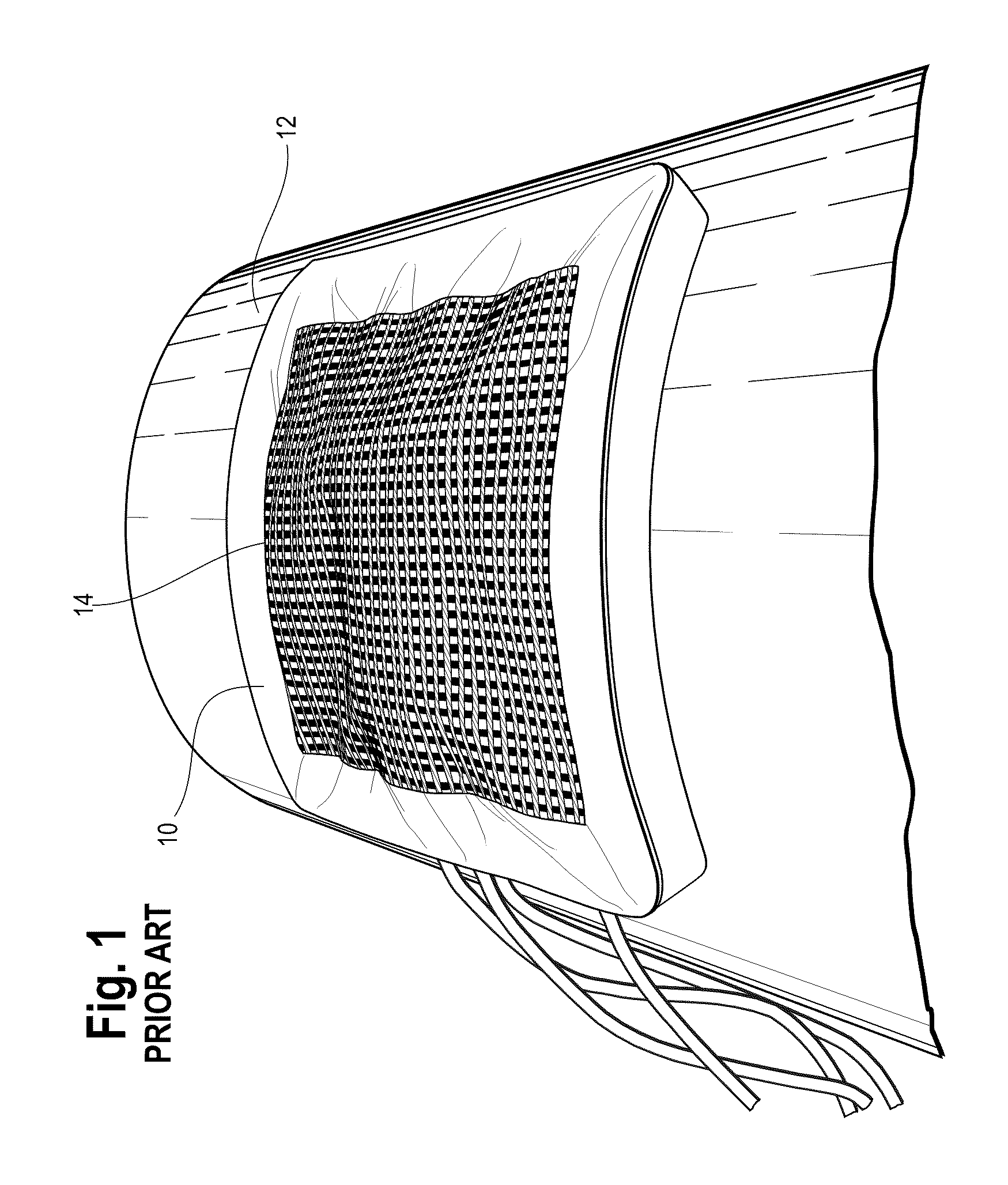Dry-coupled permanently installed ultrasonic sensor linear array
a technology of ultrasonic sensors and linear arrays, applied in the direction of instruments, magnetic property measurements, analysing solids using ultrasonic/ultrasonic/infrasonic waves, etc., can solve the problems of signal loss or inaccurate reading, high manufacturing cost of ultrasonic sensors, signal problems
- Summary
- Abstract
- Description
- Claims
- Application Information
AI Technical Summary
Problems solved by technology
Method used
Image
Examples
example 1
Prior Art
[0066]A known flexible ultrasonic array 10 has a square configuration of ultrasonic transducer elements vacuum attached to a pipe 12, as shown in FIG. 1. The array 10 of FIG. 1 included 1024 transducer elements 14 having 0.25 inch (6.35 mm)×0.25 inch (6.35 mm) size and arranged in a 32×32 square element matrix. The array 10 was vacuum coupled to a 12 inch (30.5 cm) diameter pipe 12. The dimensions of the active area of the array 10 were 8 inches (20.3 cm) by 8 inches (20.3 cm) for a total inspection area of 64 square inches (162.6 cm squared). Vacuum couplings did not provide a permanent mounting solution and failed due to leakage and / or thermal cycling.
example 2
0 Degree Wall Thickness Array
[0067]As shown in FIG. 2, a first prototype was constructed in 0 (zero) degree (angle of incidence) configuration. The 0 degree linear array 20 was tested using a 32 channel Array Scanner (not shown) from HD Laboratories, Inc (Issaquah, Wash. USA) by attaching an 8 inch×8 inch (203 mm×203 mm) blanket circuit board 22 with wires 24. The scanner stores and / or places in memory all scanned data. The device could be configured to display any combination of the “A”, “B-X”, “B-Y”, “C”, and “C-TOF”. Once the scan is stored, the gates were manipulated to study any portion of the scan. Tests were conducted with dry-coupled interfaces 26, where no wet couplants, adhesives and / or vacuum pressure were used to assist with ultrasonic transmission. The tests were performed at room temperature.
[0068]The linear array of this invention was fabricated with a 0 degree wall thickness configuration in FIG. 2. The 0 degree array 20 for sensing wall thickness included thirty-two...
example 3
TOFD Array
[0069]A second prototype was constructed as above except configured to be a TOFD array 42 with thirty-two 8 MHz ¼ inch (6.35 mm) diameter elements or sensors 44 for both the transmitters and the receivers mounted on a dry-coupling 46 of RTV 615 segmented in a wedge strip, as shown in FIG. 5. The TOFD array 42 as shown in FIG. 5 is connected to an 8 inch x 8 inch (203 mm×203 mm) array circuit board 48 for testing with the scanner (not shown) with wires 50. The wedges were cast to the correct incident angle in molds. Due to the large sonic velocity difference between the RTV615 and the carbon steel, the mold angles were controlled to tight tolerances.
[0070]A chip mounting and a chip placement mold was designed and fabricated as shown in FIG. 6. FIG. 6 shows the molds 30, such as where the lower mold is typical of the segmented wedge molds 30. A chip alignment tool is shown at the top of FIG. 6.
[0071]FIG. 7 shows a notched test block 54 with a series of cracks or notches 56 t...
PUM
 Login to View More
Login to View More Abstract
Description
Claims
Application Information
 Login to View More
Login to View More - R&D
- Intellectual Property
- Life Sciences
- Materials
- Tech Scout
- Unparalleled Data Quality
- Higher Quality Content
- 60% Fewer Hallucinations
Browse by: Latest US Patents, China's latest patents, Technical Efficacy Thesaurus, Application Domain, Technology Topic, Popular Technical Reports.
© 2025 PatSnap. All rights reserved.Legal|Privacy policy|Modern Slavery Act Transparency Statement|Sitemap|About US| Contact US: help@patsnap.com



